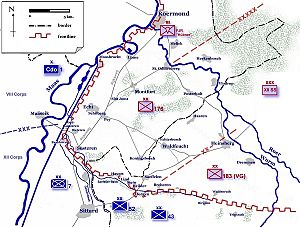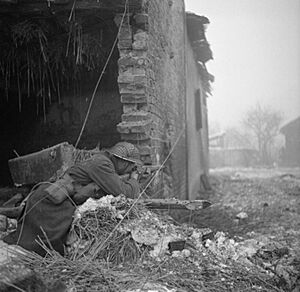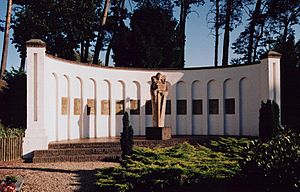Operation Blackcock facts for kids
Quick facts for kids Operation Blackcock |
|||||||
|---|---|---|---|---|---|---|---|
| Part of the Western Front of World War II | |||||||
 Dispositions in the Roer Triangle, January 1945. |
|||||||
|
|||||||
| Belligerents | |||||||
| Commanders and leaders | |||||||
| Units involved | |||||||
|
Regiment Hübner |
||||||
| Strength | |||||||
| 1 armoured division 2 infantry divisions 1 commando brigade |
2 infantry divisions 2 paratroop regiments 1 heavy panzer battalion |
||||||
| Casualties and losses | |||||||
| 1,152 casualties 20 tanks destroyed 23 tanks broken down 4 aircraft destroyed 2 aircraft crashed |
2,000 casualties | ||||||
Operation Blackcock was a military plan during World War II. It aimed to remove German soldiers from an area called the Roer Triangle. This area was located between the towns of Roermond and Sittard in the Netherlands, and Heinsberg in Germany.
The British Second Army carried out this operation from January 13 to 26, 1945. Their main goal was to push the German 15th Army back across the Roer and Wurm rivers. This would move the battle line deeper into Germany. Lieutenant-General Neil Ritchie's XII Corps led the operation. Three divisions took part: the 7th Armoured Division, the 43rd (Wessex) Infantry Division, and the 52nd (Lowland) Infantry Division. The operation was named after the Scottish male black grouse bird.
Contents
The Front Line in the Roer Area
By late 1944, the battle line in Dutch Limburg was steady. It followed several natural barriers like rivers. The River Maas was a major obstacle, running along the Dutch–Belgian border. Another important river was the River Roer. It flowed from the German Eifel area through Heinsberg to Roermond, where it joined the Maas.
South of Heinsberg, the Siegfried Line (also known as the 'West Wall') followed the Roer's banks. Southern Dutch Limburg had been freed in September by the American army. However, the area north of the Sittard–Geilenkirchen line was still held by German forces. Here, the front line was set along a small creek called the "Saefeller Beek." This creek was also hard to cross.
These natural barriers formed a triangular area. It was known as the Roermond Triangle. This area stuck out into the Allied front line. Because of a big German attack in the Ardennes (the Battle of the Bulge), the Allies moved some of their forces away. The British Second Army's XII Corps then took over guarding the front line north of Sittard for the American army. The British VIII Corps guarded the Maas front.
The British XII Corps faced the German XII SS Corps. This German force was led by Günther Blumentritt. It had two infantry divisions along the front line between Geilenkirchen and Roermond. In the Roermond area, these divisions were made stronger by the Fallschirmjäger-Regiment Hübner.
Operation Blackcock's Plan
The plan to clear the Roer Triangle involved attacks along three main directions.
Three Attack Routes
- The left attack was led by the 7th Armoured Division. Their goal was to capture the bridge over the Roer River in Sint Odiliënberg (51°8′55.9″N 6°0′12.6″E / 51.148861°N 6.003500°E). This division would start by building bridges over creeks south of Susteren.
- The center attack was carried out by the 52nd Infantry Division. Their aim was to capture Heinsberg. To do this, they needed to break through the German defense line near Hongen. This would open the road between Sittard and Heinsberg for troops to move.
- The right attack was handled by the 43rd Infantry Division. Their mission was to clear the area southeast of Dremmen. This attack would use the gap created by the 52nd Lowland Division's breakthrough.
Heroic Actions and Awards
Two soldiers received the Victoria Cross, the highest award for bravery, for their actions during Operation Blackcock. Both awards were given after the soldiers had died.
- Fusilier Dennis Donnini of the 4/5 Royal Scots Fusiliers, part of the 52nd Lowland Division, earned the VC. This was for his brave actions in the village of Stein in Selfkant on January 18. Fusilier Donnini is buried at the Sittard War Cemetery in the Netherlands.
- Lance Corporal Henry Eric Harden of the Royal Army Medical Corps (RAMC) was a medical helper with 45 Commando. He was awarded the VC for his heroic efforts during fierce fighting. This happened in the Dutch villages of Brachterbeek and Linne on January 23. Lance Corporal Harden is buried at Nederweert War Cemetery in the Netherlands.
The Battle for Sint Joost
The fight for the Dutch village of Sint Joost was a key moment in Operation Blackcock. After four days of fighting, the Germans knew the British armored division relied heavily on roads. This was especially true because of the bad winter weather. The small village of Sint Joost was on the 7th Armoured Division's path north towards Montfort.
On January 20, infantry and cavalry units of the "Desert Rats" (the 7th Armoured Division) attacked Sint Joost. They believed two German companies of the 2nd Battalion Fallschirmjäger Regiment Hübner were there. It took four attacks to clear the village. The final attack happened on Sunday, January 21.
In total, sixty Fallschirmjäger (German paratroopers) were captured. The 9th Durham Light Infantry and 1st Rifle Brigade had many losses in Sint Joost. The Durham Light Infantry had 33 casualties, with eight soldiers killed. The Rifle Brigade had 34 casualties, with three men from I Company killed. More than one hundred German soldiers died. German paratroopers who were not killed only left their hiding places in cellars with civilians. They were afraid they would be shot by the winning side. Hübner's forces lost one company, and another was almost completely destroyed.
Bombing of Montfort
Between the evening of January 19 and January 23, the Dutch village of Montfort was shelled or bombed seven times. The village was hit by over 100 bombs, mostly in the center. Nearly all of the 250 houses were damaged. During these attacks, German soldiers hid in cellars with civilians or in nearby wooded areas.
The bombings on January 21 and 22 were carried out by the Royal Canadian Air Force (RCAF). Their 2nd Tactical Air Force - No. 83 Group - 143 Wing was responsible. This Wing included 438, 439, and 440 Squadrons, based at Eindhoven. These squadrons used the Hawker Typhoon 1B fighter bomber aircraft. The 143 Wing lost six aircraft during Operation Blackcock. Two of these crashed in Montfort. When the "Desert Rats" finally freed Montfort on January 24, 186 civilians had died in the raids.
What Happened Next
Operation Blackcock was a success for the Allies. All their goals were achieved. The German divisions were pushed out of the Roer Triangle. Only the area immediately south of Roermond remained under German control, where Hübner's paratroopers stayed.
The 52nd Lowland British Division fought the hardest battles. They had 752 casualties, with 101 soldiers killed. Another 258 soldiers were sent away from the front due to sickness. This was mostly because of the very bad weather. The 7th Armoured Division had just over 400 casualties. Their vehicle losses were light. Only 20 tanks were destroyed by the enemy, and 23 more broke down due to mechanical problems. Ten of the destroyed tanks were beyond repair.
The Germans had about 2,000 casualties. During the operation, the "Desert Rats" captured 490 prisoners, including six officers. The Lowland Division captured over 1,200 prisoners, and the Wessex Division took about 400 soldiers captive.
After Operation Blackcock finished, plans for capturing the Rhineland could begin. Operation Veritable, led by the First Canadian Army, started on February 8. It aimed to break through German defenses in the Klever Reichswald, about 60 kilometers (37 miles) north of the Roer Triangle.
Operation Grenade, the southern part of the attack, was launched by the US Ninth Army on February 23. General William Hood Simpson's US Ninth Army crossed the Roer river south of Heinsberg early on February 23, 1945. Twelve hours later, Simpson had 16 battalions on the east bank. They also had seven heavy bridges and several light assault bridges. American losses were light on the first day. They captured 700 prisoners. A special force was created by the Ninth Army's XVI Corps. This force quickly moved towards Venlo to meet the British in the north. On March 1, Roermond was captured by a scouting team from the US 35th Infantry Division. They took the town without firing a single shot.



